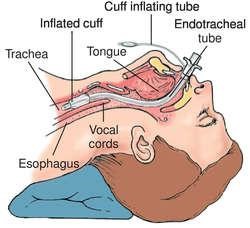A nurse is suctioning the airway of a client who is receiving mechanical ventilation via an endotracheal tube. Which of the following findings should the nurse identify as an indication that the suctioning has been effective?
Thinning of mucous secretions
Decreased peak inspiratory pressure
Presence of a productive cough
Flattening of the artificial airway cuff
The Correct Answer is B
Choice A reason
While thinning of secretions can be a positive sign, it's not always visible. A decrease in peak inspiratory pressure is a more objective indicator of improved airway patency.
Choice B reason.
Peak inspiratory pressure is the maximum pressure required to push air into the lungs. If suctioning is effective, it will remove secretions and reduce airway resistance, leading to a decrease in peak inspiratory pressure.
Choice C reason:
While a productive cough can indicate that secretions are being moved, it doesn't directly measure the effectiveness of suctioning.
Choice D reason:
Flattening of the artificial airway cuff: Flattening of the artificial airway cuff is not a relevant indicator of the effectiveness of suctioning. The cuff of an endotracheal tube is inflated to prevent air leaks around the tube and to maintain proper ventilation. It is not directly related to the effectiveness of suctioning.

Nursing Test Bank
Naxlex Comprehensive Predictor Exams
Related Questions
Correct Answer is A
Explanation
A. Borderline personality disorder is characterized by a pervasive pattern of instability in interpersonal relationships, self-image, and affect, as well as marked impulsivity and recurrent suicidal behavior. The client's history of seeking counseling for relationship problems and self-inflicted lacerations are consistent with this disorder. Therefore, this choice is correct.
B. Antisocial personality disorder is characterized by a disregard for and violation of the rights of others, as well as a lack of remorse for one's actions. The client's behavior does not indicate this disorder. Therefore, this choice is incorrect.
C. Histrionic personality disorder is characterized by excessive emotionality and attention-seeking behavior, as well as a tendency to dramatize situations and exaggerate emotions. The client's behavior does not indicate this disorder. Therefore, this choice is incorrect.
D. Paranoid personality disorder is characterized by a pervasive distrust and suspiciousness of others, as well as a tendency to interpret others' motives as malevolent. The client's behavior does not indicate this disorder. Therefore, this choice is incorrect.
Correct Answer is A
Explanation
Correct answer: A. Have the child take a tub bath each morning
A. Have the child take a tub bath each morning: Warm tub baths are recommended for children with juvenile idiopathic arthritis (JIA) as they help to relieve joint stiffness and pain, especially in the morning. The warm water can soothe the joints, making movement easier and reducing discomfort throughout the day.
B. Apply splints to the child's extremities during the day: While splints may be used in JIA, they are typically applied during the night (resting splints) to maintain joint position and prevent contractures. Daytime use of splints (working splints) may be considered in certain situations, but generally, children are encouraged to be as active as possible during the day to maintain joint mobility.
C. Encourage the child to take naps during the day: While rest is important, encouraging too much rest during the day may contribute to joint stiffness. Regular activity helps maintain joint function and mobility, which is essential in managing JIA.
D. Keep the child on bedrest as long as pain persists: Prolonged bedrest is not recommended for children with JIA. It can lead to muscle atrophy, increased stiffness, and reduced joint mobility. Instead, the focus should be on maintaining activity within the child's pain tolerance and using pain management strategies.
Whether you are a student looking to ace your exams or a practicing nurse seeking to enhance your expertise , our nursing education contents will empower you with the confidence and competence to make a difference in the lives of patients and become a respected leader in the healthcare field.
Visit Naxlex, invest in your future and unlock endless possibilities with our unparalleled nursing education contents today
Report Wrong Answer on the Current Question
Do you disagree with the answer? If yes, what is your expected answer? Explain.
Kindly be descriptive with the issue you are facing.
